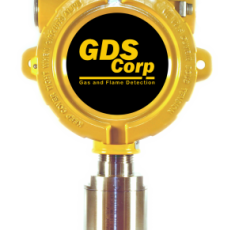Hydrogen sulfide is major concern to many industries ranging from oil and gas to municipal services. It makes sense to familiarize yourself with what a H2S monitor is and the many features they provide to accomplish robust and accurate hydrogen sulfide monitoring.
-H2S Sensor Types
In industrial settings, there are generally three types of hydrogen sulfide sensors; Metal Oxide Sensing [MOS], Electrochemical, and Optical Sensing Technology. Metal oxide sensors are typically more resilient to humidity and temperature in comparison to other types. The downside is a slow response time and occasional failure until “bump tested” with a higher concentration of H2S with no failure mode. Electrochemical sensors operate using the laws of diffusion and an electrochemical reaction. That sounds great and high tech, but chemical reactions are greatly influenced by temperature, and as such they are a poor choice for austere environments such as a desert or the Artic. Optical sensing technology uses the concept of absorption and measuring the differences in intensity of IR or UV to determine the concentration of H2S. They are a robust solution that is field proven, but they tend to be quite expensive.
-I/O Configuration Options
Typically, a H2S monitor will have a 10-30VDC power similar to most transmitters utilized in control loops. The input points usually allow you to pick between a digital sensor, bridge-style direct sensor and a 4-20 mA analog input. A H2S monitor will also come with a number of programmable relays as an option and the industry standard 4-20 mA output. With the 4-20 mA output, the systems integrator must process that signal with a compute or scaling function at the PLC in order to determine the H2S concentration in PPM. The programmable relays on the H2S monitor provide an alternate way to indicate potentially dangerous hydrogen sulfide levels without relying on a PLC. It is possible to tie these relays to a siren or a strobe light to indicate the area is unsafe and requires operators to wear a self-contained breathing apparatus
-Communications
A good hydrogen sulfide monitor will have a wide variety of communication options. Ethernet is becoming much more common than in years past and is rapidly become the industry standard with the Industrial Internet of Things (IIoT). Typically, the OEM will have a web server on the device that allows configuration. With 10/100 Ethernet capability, it is important to note that the Ethernet/IP, Modbus/TCP and other standards such as EtherCAT can be utilized. Additionally, it is worth mentioning that RS-485 is usually an option on most monitors to support legacy control systems. The advantage of having a multitude of different communication options is ease of calibration.
-Certifications
The final check on H2S Monitors is to ensure that it will be built like a tank for your environment. The main certification you want is CSA Class I, Division 1, Groups B, C, D. You want this because your monitor will be located where there is an explosive gas present.

